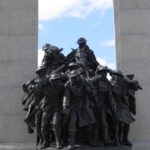Canada’s Military in the Boer War: A Comprehensive Survey
The Boer War, fought from 1899 to 1902, marked Canada’s first major overseas military involvement. It was a conflict that drew this young and growing dominion into the politics of imperialism, cementing its role within the British Empire while also highlighting its budding independence. For the first time, Canadian soldiers fought on foreign soil as part of Britain’s imperial army, and the war helped to shape Canada’s evolving military identity. This essay explores the military and political conditions in Canada before the war, the reasons for the conflict, the reaction to its outbreak, the mobilization of Canadian forces, their participation in the fighting within the broader British war effort, the politics of the Canadian military in relation to the British Empire, the impact on the home front, and how the war contributed to the development of Canada’s armed forces.
Pre-War Conditions in Canada
At the close of the 19th century, Canada was a dominion that had not yet fully come into its own. Though Confederation had occurred in 1867, binding together the provinces of Ontario, Quebec, Nova Scotia, and New Brunswick, the country was still carving out its place in the world. By the 1890s, Canada had expanded significantly westward, absorbing Manitoba, British Columbia, and the Northwest Territories. The completion of the transcontinental railway in 1885 had solidified the country’s physical unity, but the national identity remained fragmented. Canada was a patchwork of English and French settlers, Loyalists and recent immigrants, as well as Indigenous peoples, whose presence was often sidelined by the colonial agenda.
Economically, Canada was still heavily reliant on Britain. The country exported its natural resources—lumber, wheat, and minerals—across the Atlantic, while its financial markets were deeply tied to British capital. Politically, Canada’s foreign policy and defense remained largely controlled by the British government, though Prime Minister Sir Wilfrid Laurier sought to assert greater Canadian autonomy within the Empire. Laurier, a French-Canadian Liberal, found himself navigating the complex waters of Canadian loyalty to the British Crown and growing nationalist sentiments.
Militarily, Canada’s armed forces were modest. The Permanent Active Militia, Canada’s standing army, numbered only about 1,000 men, primarily stationed in eastern Canada. They were professional soldiers, but they were few and far from being an expeditionary force. More significant was the Non-Permanent Active Militia, which numbered around 36,000 part-time volunteers scattered across the provinces. These were civilians who trained sporadically and were called up in emergencies, but they lacked the discipline and cohesion of professional soldiers. The militia was intended primarily for domestic defense, tasked with responding to local crises rather than fighting in far-off colonial wars.
Although Canada’s military forces were not yet prepared for large-scale overseas engagements, the seeds of a modern army had been planted. Canada’s contribution to British defense still relied heavily on Britain’s regular forces and the Royal Navy. The concept of deploying Canadian troops to defend Britain’s imperial interests abroad, particularly in South Africa, was foreign to many Canadians in the late 1890s.
Why the Boer War Started
The Boer War was the result of deep-rooted imperial tensions in southern Africa. For most of the 19th century, Britain’s interests in the region were primarily focused on maintaining control of the Cape Colony and its important shipping routes around the southern tip of Africa. However, the discovery of vast gold and diamond reserves in the Boer republics—the South African Republic (Transvaal) and the Orange Free State—drew Britain into conflict with the Boers, descendants of Dutch settlers who had long sought to maintain their independence from British rule.
By the 1890s, Britain, driven by a desire to consolidate its imperial control over southern Africa, sought to undermine the independence of the Boer republics. The British supported the influx of British settlers, known as Uitlanders, into the gold-rich areas of the Transvaal, creating tensions with the Boer government. The Boers, led by President Paul Kruger, resisted British efforts to control their territory, resulting in escalating diplomatic disputes. When negotiations over the rights of British settlers in the Boer republics broke down, and Britain continued to assert its imperial authority, war became inevitable.
In October 1899, Boer forces, fearing further British encroachment, launched a preemptive strike against British garrisons in Natal and the Cape Colony, igniting the Second Anglo-Boer War. The conflict would soon expand, drawing in British forces from across the Empire, including Canada.
Canada’s Reaction to the Outbreak of War
In Canada, the outbreak of the Boer War posed a significant political dilemma. As a dominion of the British Empire, Canada was expected to contribute to Britain’s military efforts, but the question of whether to send troops to fight in a foreign, imperial war was deeply divisive. The issue split the country along linguistic and regional lines, reflecting the broader cultural and political tensions that characterized late 19th-century Canadian society.
In English-speaking Canada, particularly in Ontario and the Maritimes, there was strong support for the war. Many English Canadians saw themselves as loyal subjects of the British Crown, and newspapers were filled with stories celebrating British imperialism and calls for Canada to stand by Britain. The British Empire, in their view, was a force for stability and civilization, and Canada had a duty to support Britain in its efforts to defend and expand its imperial interests.
However, in French-speaking Quebec, there was significant opposition to the war. Many French Canadians, still deeply suspicious of British imperialism and resentful of their treatment under British rule, saw the war as a foreign conflict that had nothing to do with Canada’s interests. Leading French-Canadian nationalists, such as Henri Bourassa, argued that Canada should focus on its own development rather than becoming entangled in Britain’s colonial ambitions. Bourassa and others feared that sending Canadian troops to fight in South Africa would set a dangerous precedent, dragging Canada into future imperial conflicts.
Caught in the middle of this debate was Prime Minister Wilfrid Laurier. As a French-Canadian Liberal leader, Laurier had built his political career on maintaining unity between English and French Canadians. He recognized that outright refusal to support Britain in the war would alienate English Canadians and jeopardize Canada’s position within the Empire. On the other hand, he could not afford to ignore the opposition from Quebec, where much of his political base was located.
Laurier’s solution was a compromise: Canada would send a contingent of troops to South Africa, but only on a voluntary basis. In October 1899, Laurier authorized the recruitment of 1,000 Canadian volunteers, who would serve under British command in South Africa. The government would cover the costs of equipping and transporting the troops, but it would not impose conscription or force Canadians to fight in the war. This compromise allowed Laurier to appease both English-Canadian imperialists and French-Canadian nationalists, while maintaining Canada’s delicate balance between loyalty to Britain and emerging national autonomy.
Mobilization of Canadian Forces
The mobilization of Canadian forces for the Boer War was a momentous occasion in the country’s military history. This was the first time that Canada had sent troops to fight overseas as part of a British imperial campaign, marking a significant step in the development of Canada’s armed forces and its role within the British Empire.
The first contingent, known as the 1st Canadian Contingent, was drawn primarily from the Permanent Active Militia and the Non-Permanent Active Militia. The volunteers were quickly assembled and sent to Camp Valcartier near Quebec City, where they underwent a brief period of training before embarking for South Africa in October 1899. The volunteers were largely young men from English-speaking provinces, eager for adventure and driven by patriotic fervor. Many saw the war as an opportunity to prove their loyalty to Britain and to demonstrate Canada’s growing military capabilities.
Over the course of the war, Canada sent several more contingents to South Africa, including mounted rifles, artillery units, and additional infantry battalions. By the end of the conflict, over 7,000 Canadian soldiers had served in South Africa. The Canadian government continued to stress that these were volunteer forces, and no conscription was imposed. Laurier’s insistence on voluntarism allowed him to maintain political stability at home while still contributing meaningfully to the British war effort.
Canadian Military Participation in the Boer War
The Canadian soldiers who served in the Boer War quickly found themselves facing a type of warfare they had never encountered before. The Boer War was characterized by the use of guerrilla tactics, with the Boer forces—highly mobile and familiar with the rugged South African terrain—relying on ambushes, hit-and-run attacks, and defensive positions in the arid, open plains of the veldt. The Canadian troops, trained for more conventional European-style warfare, had to adapt quickly to these new conditions.
One of the first major engagements involving Canadian forces was the Battle of Paardeberg in February 1900. The British army, under the command of Lord Roberts, was attempting to relieve the besieged city of Kimberley and drive Boer forces from the Orange Free State. The Canadians were part of a larger British force that encircled the Boer army at Paardeberg. After a week of intense fighting, including a daring nighttime assault by the Canadians, the Boers surrendered. The victory at Paardeberg was a turning point in the war and marked the first major success for Canadian troops in an overseas conflict.
The Canadians continued to distinguish themselves in subsequent engagements. In November 1900, at the Battle of Leliefontein, a small detachment of Canadian mounted rifles successfully repelled a larger Boer force, protecting the retreat of British artillery units. Throughout the war, Canadian troops earned a reputation for their discipline, resilience, and effectiveness in battle, gaining the respect of their British commanders.
However, as the war dragged on, it entered a more grueling phase. By late 1900, the Boers had shifted from conventional warfare to a guerrilla campaign, avoiding direct confrontations and relying on their knowledge of the terrain to launch surprise attacks on British columns. Canadian mounted units, particularly the Royal Canadian Dragoons, played a key role in countering these guerrilla tactics, patrolling the vast South African countryside, engaging Boer commandos, and protecting British supply lines.
Despite the successes, the war was costly and difficult. Canadian soldiers, like their British counterparts, faced harsh conditions in the South African wilderness—extreme heat, limited supplies, and the constant threat of ambush. Disease was rampant, and many soldiers fell ill in the unsanitary camps. Nevertheless, Canadian troops persevered, and their contributions to the British war effort were widely recognized both at home and abroad.
The Politics of Canadian Military Forces in Relation to the British Empire
The Boer War was not just a military conflict; it was also a political and diplomatic event that tested Canada’s relationship with the British Empire. Canada’s participation in the war highlighted the country’s dual identity as both a loyal dominion of Britain and an emerging nation with its own interests and priorities.
For many Canadians, particularly in the English-speaking provinces, participation in the war was a matter of imperial duty. They viewed Canada as a key part of the British Empire and believed that the country had a responsibility to support Britain in its struggles abroad. This sense of imperial loyalty was deeply ingrained in the political culture of English-speaking Canada, where newspapers and public figures celebrated the country’s role in the war.
However, the war also underscored the growing sense of Canadian nationalism, particularly in French-speaking Quebec. The opposition to the war in Quebec reflected a broader desire for greater autonomy from Britain. Many French Canadians, led by Henri Bourassa, argued that Canada should chart its own course in world affairs, rather than blindly following Britain’s lead. Bourassa’s arguments resonated with a significant portion of the population, and his criticism of the war laid the groundwork for the growing nationalist movement in Quebec.
Prime Minister Laurier’s decision to send only volunteer forces was a reflection of Canada’s delicate position within the Empire. Laurier recognized the importance of maintaining good relations with Britain, but he was also acutely aware of the need to assert Canada’s independence in matters of foreign policy. By limiting Canada’s involvement to a voluntary force, Laurier was able to balance the demands of imperial loyalty with the desire for greater autonomy. This compromise allowed Canada to contribute meaningfully to the British war effort without provoking a major political crisis at home.
For Britain, Canada’s participation in the Boer War was significant. It demonstrated that the dominions were willing and able to contribute to the defense of the Empire, and it reinforced the idea of a united imperial defense system. The war also revealed the limitations of Britain’s military power, as the British army struggled to suppress the Boer guerrillas despite its numerical superiority. Canada’s contributions, though small in comparison to Britain’s overall forces, were appreciated, and they helped strengthen the ties between the two countries in the years that followed.
Areas of Canadian Commitment in South Africa
Canadian forces were deployed to several key areas of the Boer War, primarily in the Orange Free State and the Transvaal, where the fighting was most intense. The war was fought across a vast and often inhospitable landscape, with the Canadian soldiers facing long marches, difficult terrain, and a determined enemy.
In the early stages of the war, Canadian troops were involved in major battles such as Paardeberg, where they played a decisive role in the British victory. As the war shifted to a guerrilla campaign, Canadian mounted units became increasingly important. The Royal Canadian Dragoons and other mounted rifles units were tasked with patrolling the South African countryside, engaging Boer commandos in skirmishes, and protecting British supply lines. These operations were often grueling, with Canadian soldiers covering vast distances in search of the elusive Boer forces.
In addition to their combat duties, Canadian soldiers also took part in the occupation and pacification of Boer territories, helping to secure British control over key areas. They were involved in the establishment of blockhouses and fortifications, which were used to limit the movement of Boer guerrillas and protect British supply routes.
Home Front Reaction in Canada
The Boer War had a profound impact on the home front in Canada. While English-speaking Canadians generally supported the war, the conflict deepened divisions between English and French Canadians. In Ontario and the Maritimes, newspapers celebrated Canada’s involvement in the war, and returning soldiers were hailed as heroes. Public events were held to honor the troops, and there was a sense of pride in Canada’s contributions to the British war effort.
In Quebec, however, the reaction was far more muted. French-Canadian nationalists, led by Henri Bourassa, opposed the war and argued that Canada should focus on its own interests rather than becoming entangled in Britain’s imperial conflicts. The war exacerbated tensions between English and French Canada, and it became a rallying point for those who sought greater autonomy from Britain. These divisions would resurface in future conflicts, particularly during the First World War, when the issue of conscription would once again divide the country.
Despite the political tensions, the war also contributed to a growing sense of national pride in Canada. The success of Canadian soldiers in South Africa demonstrated that the country was capable of contributing to global military efforts, and it helped to foster a sense of Canadian identity within the broader framework of the British Empire.
The Development of Canada’s Armed Forces
The Boer War marked a turning point in the development of Canada’s military. Prior to the war, Canada’s armed forces had been primarily focused on domestic defense, with little thought given to participation in overseas conflicts. However, the experience of sending troops to South Africa helped to professionalize Canada’s military and laid the groundwork for future contributions to imperial defense.
The war revealed the importance of having a well-trained and well-equipped military force that could be deployed quickly in times of crisis. While the Canadian militia had performed admirably in South Africa, the war highlighted the need for greater investment in training, equipment, and organization. In the years following the Boer War, the Canadian government began to take steps to modernize its military, establishing new training programs and expanding the size of the Permanent Active Militia.
The Boer War also set a precedent for Canada’s involvement in future conflicts. The experience of sending volunteer forces to South Africa paved the way for Canada’s much larger contributions to the First and Second World Wars. The war demonstrated that Canada could play a meaningful role in global military affairs, and it helped to shape the country’s evolving relationship with Britain and the wider world.
Conclusion: The Boer War’s Legacy
The Boer War was a defining moment in Canada’s military and political history. It marked the first time that Canadian troops had fought overseas as part of a British imperial campaign, and it helped to shape Canada’s identity as both a loyal dominion of Britain and an emerging nation with its own interests. The war highlighted the deep divisions within Canadian society, particularly between English and French Canadians, but it also fostered a sense of national pride and military capability.
For Canada, the Boer War was a stepping stone on the path to greater independence and autonomy within the British Empire. The country’s contributions to the war demonstrated its growing military capabilities and its willingness to support Britain in times of need, but it also underscored the importance of maintaining a balance between loyalty to the Empire and the assertion of national identity.
In the years that followed, Canada’s military would continue to evolve, drawing on the lessons of the Boer War to prepare for the much larger conflicts that lay ahead. The war may have been a small chapter in the broader history of British imperialism, but for Canada, it was a significant step toward becoming a more confident and capable nation on the world stage.



